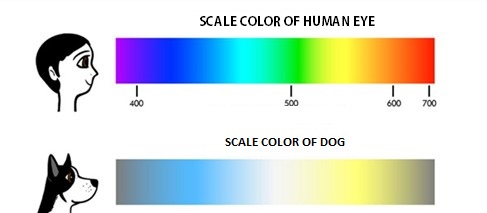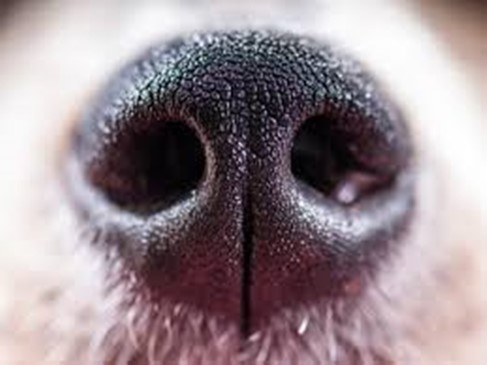The number of registered
animals is growing every day
Published: Feb 4, 2020

So, what is true and what is not about the behaviors and characteristics of dogs and cats?
Origin: The etiology of this myth is unknown.
Vision involves many factors that cause differences in perception between different species of animals and humans. These include sensitivity to movement, light, and flickering lights, the range of the visual field, as well as sharpness and color vision.
Until recently, it was believed that dogs could not distinguish colors, but research has shown that their retinas contain so-called cones, which are responsible for color vision. It should be emphasized that the colors seen by dogs differ from how humans see them. They are not as saturated and clear, and their range is much narrower.

Truth: Dogs can see colors but differently than humans. They have a reduced ability to differentiate colors. Veterinary ophthalmologists from the Russian Academy of Sciences have determined that dogs' eyes have receptors that perceive colors in shades of blue and green but do not see shades of red. It has been established that dogs have only two types of receptors responsible for distinguishing colors, unlike humans, who have three types. As a result of experiments, it was shown that dogs cannot distinguish yellow, green, and red from each other but can identify different shades of blue, violet, and gray. It should also be noted that they perceive many more shades of gray than humans. Dogs also have more rods responsible for better vision in low light, and the world they see is much brighter than what humans see, so they can see better at night and adapt better to a nocturnal lifestyle.
Dogs are nearsighted and have difficulty seeing objects or people clearly from more than 7 meters away; they perceive movement, but the details of objects are invisible.
Origin: The most popular myth in the cat world. In reality, although cats instinctively land on their feet, they frequently break bones or suffer other injuries during falls from heights.

Cats are predators that, due to their physique, prefer climbing rather than running, and in stressful situations, they skillfully jump to high places. A frightened cat will quickly jump onto a tree, but it may have trouble getting down since they do not tolerate descending head-first and usually choose to jump off.
From small heights and with controlled movements, a cat lands in the desired position, aiming its paws downward and usually lands on all fours. The situation changes when an animal falls from great heights. Physicists believe that during falls/jumps from high altitudes, cats intuitively adjust their speed and rotation time by retracting their paws, straightening their tails, and arching their backs. Intuition and the flexible structure of a cat's spine allow it to cushion the fall and survive. It is also assumed that a cat that falls from a significant height has a better chance of survival because at high distances, the cat's body assumes a parachute-like shape, allowing it to land on its paws. During shorter falls, the cat may not have time to turn around. Additionally, during the flight, it tilts its head backward toward the spine, and its muscles cannot adequately support the neck, which can lead to a broken jaw, mandible, or even teeth. Usually, the cat is upside down in the air and changes this position during the fall, intuitively making appropriate tail movements. Its light and flexible spinal structure help cushion the impact. The absence of a clavicle allows the free rotation of the torso. Another factor is that the inner ear of cats contains specialized organs, which, together with the eyes, send information to the brain about the position of the head relative to the ground. However, this does not mean that any fall is safe for a cat. Concussions, fractures of the limbs, spine, and traumatic shock syndrome, as well as damage to internal organs, are common during such unplanned emergency landings. There is also the risk of developing DIC syndrome, which is fatal.
Truth: This myth is perhaps one of the most well-known and dangerous misconceptions about cats, posing a threat to their lives. Cats are indeed very athletic and agile, with a unique system of instinctively rotating in the air to improve their position during a fall. However, if a cat is surprised, sick, disoriented, or injured, it is unlikely to adjust its body position for landing. Additionally, the impact force alone can cause serious injuries or death.

Origin: The origin of this myth is unknown. However, it is widely believed that a dog with a dry and warm nose is sick.
This is due to tears that form to maintain proper moisture in the eyeball. In dogs, excess tears flow through the nasolacrimal ducts to the base of the nose. The dog licks the tears and spreads them on the nose, contributing to the moisture. The low temperature of the nose is caused by the evaporation of the water accumulated on it, which lowers the temperature. The mucus on the dog's nose also helps filter air, enhancing the dog's sense of smell and improving its ability to recognize scents.
1. During sleep, as the dog cannot lick its nose to spread moisture from the nasolacrimal ducts. Within about 10 minutes after waking up, the nose's temperature and moisture should stabilize.
2. Dryness of the nose also occurs when the dog is allergic to the plastic from which food and water bowls are made.
3. When the dog digs in the ground a lot, causing excessive drying and peeling of the nasal skin.
4. During hot weather, when the nose overheats and is less moisturized (it is important to protect the dog's nose with sunscreen during hot weather).
5. When the dog is dehydrated, so make sure the dog has constant access to fresh water.
6. When the dog stays in air-conditioned or heavily heated rooms for too long.
Some breeds, such as poodles, often experience blocked tear ducts, which reduces the moisture in their noses. This is a physiological phenomenon and is not a cause for concern.
As you can see, even within a single day, our dog may have a cold and wet nose at one moment and, after a few hours, a dry and warm nose, which does not necessarily indicate illness.
Symptoms that should draw our attention;
Concerning symptoms that accompany a dry nose include:
Truth: The temperature and moisture of the nose are not reliable indicators of health based solely on this symptom. A warm, dry nose does not necessarily mean illness, and conversely, a cold, wet nose does not guarantee health.
Origin: Most instances of dogs wagging their tails are associated with joy. As a result, people associate tail wagging with a happy dog.
However, tail wagging in dogs reflects various emotional states, including joy, indecision, or ambivalence towards the situation the dog finds itself in. Conflicting, often contradictory emotions the dog experiences cause tension, which is relieved by tail movements.
By moving its tail, the dog expresses both happiness and other feelings. Understanding the information depends on the frequency and position of the wagging tail. A loose tail with enthusiastic movements signals friendly intentions and happiness. Intense movements of the tail indicate submission, a stiff tail with slow movements suggests anger, and a tail tucked between the hind legs signifies fear. A tail held below or above the back line shows interest and alertness. Quick or nervous movements with a lowered tail suggest submission. The more submissive the dog, the faster the movements and the lower the tail. In dominant individuals, wagging is slower, and the tail is held high.
Truth: In many cases, a wagging dog expresses happiness or other strong emotions—much like a human smile. However, similar to human smiles, tail wagging does not always reflect happiness and positive experiences. Studies by cynologists confirm that dogs usually do not wag their tails when alone, even if they seem content. This indicates that tail movement also has a communicative function—both towards humans and other dogs.
Origin: The origin of this myth has two sources: firstly, cats are very flexible and resilient animals, even when sick or injured. They can survive situations that would likely cause death in other animals. The second source of this belief is probably rooted in Anglo-Saxon culture, where it is believed that cats have nine lives. This idea originates from the legend that cats come from ancient Egypt, where the god Atum Ra was depicted as a cat symbolized by the number nine. There are many reports of cats surviving for long periods in extremely harsh conditions, even without access to food and water.
The myth that cats always land on their four paws reinforces this belief. In some Christian cultures, which revere the number 7, there is a belief that cats have seven lives.
Truth: Of course, cats do not "have nine lives" and are mortal like all other animals. While they are agile, intelligent, and resourceful, their lives end like everyone else's on Earth.
Origin: Dog saliva was once considered an antiseptic, which is why the belief persists that it has healing properties. This myth contains a grain of truth and a significant part of legend. Dog saliva contains lysozyme in much higher amounts than human saliva, making it a stronger antiseptic than ours.
However, scientists have found, in laboratory studies, the presence of pathogenic bacteria in the dental plaque of dogs. These bacteria cause periodontal disease—a serious gum condition that destroys periodontal tissues and can eventually lead to heart disease, kidney disease, and diabetes.
Truth: Despite certain healing properties, a dog's mouth is not cleaner than a human's. Dog saliva can be toxic to some strains of bacteria, but it also contains its own cultures of bacteria and other infectious organisms that can be harmful or toxic to humans. Therefore, people with weakened immune systems and small children should limit direct contact with dog or cat saliva, and wounds should not be subjected to "therapy" with dog saliva.
Origin: The basis of this myth is unknown. It probably stems from basic mathematical calculations that the average lifespan of dogs is 10 to 12 years, which equates to 1/7 of the average human lifespan.
A dog's life is only part of the average human life. The lifespan of a dog depends, among other factors, on its breed, size, and weight. Large dogs (Bullmastiffs, Great Danes, etc.) live shorter lives than smaller breeds. A large dog's lifespan is around 8-10 years, while a small dog lives about 13-15 years. The development of large breeds in the first years is analogous to small breeds, with differences appearing in later stages of life.
Dogs have a shortened childhood and an extended adulthood. They begin walking on their own around three weeks after birth and reach physical maturity at 18 months. The aging process significantly diverges after the seventh year.
According to Kazimierz Ściesiński, an approximate comparative age chart of a dog relative to a human is as follows:
|
dog |
human |
|
6 months |
10 years |
|
10 months |
14 years |
|
12 months |
15 years |
|
18 months |
20 years |
|
2 years |
24 years |
|
3 years |
28 years |
|
4 years |
32 years |
|
5 years |
36 years |
|
6 years |
40 years |
|
dog |
human |
|
7 years |
44 years |
|
8 years |
48 years |
|
9 years |
52 years |
|
10 years |
56 years |
|
11 years |
60 years |
|
12 years |
64 years |
|
13 years |
68 years |
|
14 years |
72 years |
|
15 years |
76 years |
When assessing a dog's age, it is necessary to treat each individual case; besides size, physiological factors, such as dental condition or the amount of gray hair, should be considered. For dogs around 7 years old, wear is visible on the canines and incisors, while teeth loss occurs at 10-12 years.
Truth: Contrary to popular belief, there is no exact formula to precisely assess a dog's age relative to a human's age.
Origin: This myth likely originated from the difficulty of commanding an older dog. It is one of the most common stereotypes among laypeople about domestic dogs.
As the body ages, certain cognitive abilities are slowed and weakened, regardless of species, but this does not mean the ability to learn ceases. Dogs, like humans, retain this ability to a lesser or greater extent throughout their lives. They maintain the ability to recognize patterns and basic relationships between behavior and its positive or negative reinforcement, continue to observe how their surroundings function, and refine relationships between dogs and human-dog interactions. If the appropriate training method is selected, it is unlikely that it will not cause the desired reaction from the animal, directed towards a specific behavior.
Truth: You can teach an old dog new tricks. Dogs can learn new commands, skills, and behaviors within their physical capabilities, and with the right motivation, they usually enjoy doing so. Their minds need stimulation, just like humans. With patience, kindness, consistency, and systematic training, owners can teach their pets new commands, such as sit, down, shake, or heel. As long as the dog is willing and open to new interactions and health conditions allow, there are no contraindications to continue training with it.
Origin: This myth, like many others, has no exact origin. It probably comes from the fact that most cats do not purr when their owners are not around, but they make sounds when receiving affection from their owners, leading cat owners to interpret this behavior as a sign of happiness.
Of course, it is undeniable that purring is usually a sign of contentment, but it does not always mean the cat is happy. Usually, when a kitten rubs against its owner while purring loudly, it indicates affection or a request (e.g., for food). However, purring is also a sound that cats make when they are sad, sick, or even injured.
Frightened and stressed cats sometimes purr to comfort themselves, and similar sounds can also be heard from birthing cats!
Desmond Morris states that cats express the need for closeness in this way, such as with their caretaker. Purring plays a significant role in communication between a mother cat and her kittens, e.g., during feeding.
Truth: In most cases, purring in cats is a sign of contentment, but it is not the only reason for this behavior. Purring can also be due to poor health, caused by illness, stress, anxiety, or pain, birth, and sometimes even death. It can be said that purring expresses strong emotions—both positive and negative—and is not confined to one specific cause. Felineologists compare it to humming or whistling by humans, which most often occurs out of happiness but can also be caused by stress, fear, or discomfort.
Origin: This myth probably comes from people observing cats active at night.
Cats tend to move freely in darkness, but even a cat cannot see in total darkness. However, these animals cope well with very low light levels because their pupils dilate to make the most of available light. Due to this anatomy, a cat's eye needs about six times less light than a human eye to recognize an image under similar conditions. The eye works like a camera shutter and regulates the amount of light reaching the retina, so a cat sees almost as well in the dark as it does in daylight. It should also be emphasized that cats have blurry vision, but they distinguish silhouettes very well, and like dogs, they have a very wide field of view, which can be up to 285 degrees.
The fact that a cat manages well even in total darkness is thanks not only to its sight but also to its whiskers, which are excellent tactile receptors that help it avoid obstacles.
Truth: Although cats see better in low light than humans, they do not see in complete darkness.
Origin: This myth likely comes from dog owners observing their dogs vomiting after eating grass.
Several reasons are given for such behavior among dogs. One dominant belief is that the dog experiences gastric discomfort and, wanting to vomit, greedily swallows large amounts of grass. Long, unchewed blades of grass irritate the dog's throat, causing a gag reflex. Additionally, wild animals eat large amounts of plants to rid the digestive tract of parasites (mainly nematodes); parasites are expelled from the digestive tract along with stomach contents, wrapped in undigested grass, suggesting that these behaviors are an atavistic remnant among dogs.
The second most common explanation for our pets' consumption of grass is dietary deficiencies that may exist in the dog, prompting it to compensate for these shortages.
The last explanation for this behavior is the theory that the dog simply enjoys eating grass, and there is no reason to prevent it from doing so.
If a dog eats grass and then vomits but does not display other concerning symptoms, it is likely that the body resolved the issue on its own. However, if the dog has a gag reflex and is unable to expel stomach contents or continues eating grass and vomiting, veterinary consultation is required.
Truth: The reason dogs eat grass is not solely to purge the stomach or digestive tract of unnecessary or harmful substances. Sometimes this habit is caused by the dog's dietary needs or preferences. In extreme situations, it may indicate the need for a veterinary consultation.
No, dogs see colors differently from humans. They have a reduced ability to differentiate colors and cannot perceive shades of red but can identify various shades of blue, violet, and gray.
Although cats instinctively land on their feet, falling from great heights can cause injuries such as broken bones.
No, milk is not healthy for most cats as they may be lactose intolerant, leading to digestive problems.



Marking animals with a microchip is the most durable, effective and completely safe method of quick and reliable identification. Every transponder (chip) has a unique number which enables instant identification of the animal and its owner, helping them reunite faster. However, it is important to remember that a chip is just a transponder with an encoded number. It is not a tracking device and contains no data about the animal or the owner! Therefore, in order to identify a chipped dog or cat, it is necessary that a microchip be registered in a national marked animal database...
Read moreIn today's world, responsibility for animal care has become not only a priority for their owners but also a societal issue. One of the most important tools in ensuring animal safety is the chip database. It allows for the quick and efficient recovery of lost pets, which is crucial for protecting their health and well-being.
The introduction of microchipping has significantly improved the effectiveness of efforts to locate lost animals, reducing stress for both owners and their four-legged friends. Registration in the chip database is increasingly required by local regulations, further highlighting the importance of this technology in ensuring comprehensive care for animals.